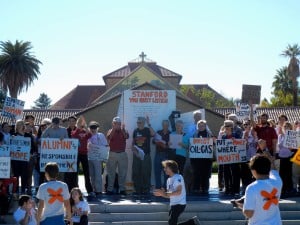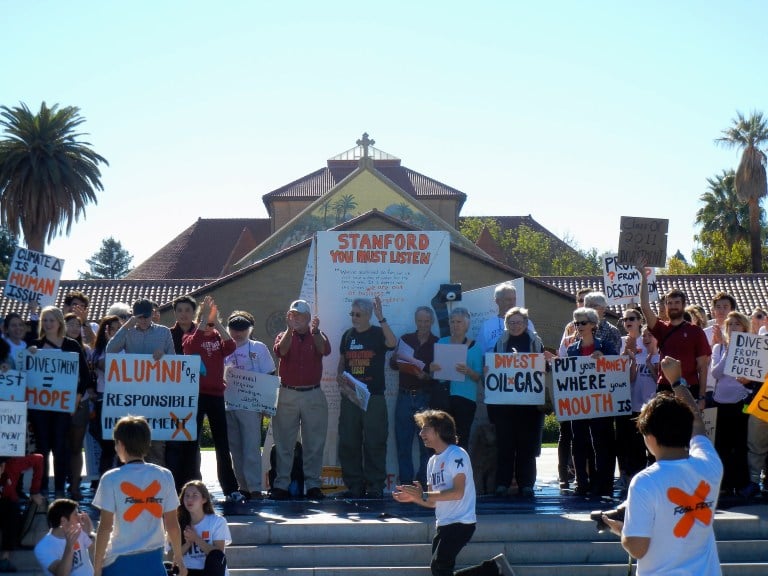
At the site of the Fossil Free Stanford (FFS) sit-in outside the president and provost’s office, wakeup times are staggered as the sun rises. Some participants, in tents, sleep longer. Others, in sleeping bags under the Main Quad arcades, begin to wake earlier. Most begin to pull out laptops, starting their work for the day.
When most of the sit-in protesters are awake, Yari Greaney ’15 M.S.’16 gathers the group for their morning meeting. In a typical day, the participants meet all together twice — once in the morning and once in the evening. Sitting in a circle on the quad, they share announcements, discuss their emotions as the sit-in continues and conclude each meeting in song.
Greaney herself has been with FFS since its conception three years ago. An earth systems undergraduate and coterminal student, Greaney has experienced the impacts of climate change firsthand with widespread forest fires and lowering reservoir levels near her home in Redding, California. For Greaney, these experiences have reinforced the need for urgency in climate action — something FFS doesn’t feel the Stanford administration has taken into account.
“Toward the end of last year, we were realizing that the University might not follow through on its commitment to act quickly,” Greaney said. “When our mentor at 350.org asked if we would be interested in escalating to nonviolent direct action, we began to plan.”
As the sit-in has progressed, Greaney said the conflict between University administration and the Stanford community has become more apparent as the community has shown “overwhelming support” over the past week of the sit-in.
There are common activities from day to day of the sit-in: homework, teach-ins, film screenings, music, art. Food is brought in from co-ops or just friends of the participants. One alumnus brought hot chocolate to warm up protesters late Wednesday night, and on Thursday afternoon more alumni walked up carrying pizzas.
Many of the amenities brought to the protesters are offered to the police standing watch at the door to Building 10 as well. Most of the time, the officers decline the offers of coffee or granola bars, but the relationship between the officers and the sit-in participants is a comfortable one.
Chris LeBoa ’19, a freshman who heard about FFS during Admit Weekend last year, has been particularly interactive with the police.
“The police officers are there because they have to be, but they have a lot of stories too,” LeBoa said. “Carol, who’s working now, actually lived on a boat… Chris, the guy in the morning, is a surfer who lives in the Santa Cruz mountains. Israel wakes up at 4 a.m. to get his kids ready for school.”
According to LeBoa, the main “sacrifice” he has made to the sit-in is that his parents haven’t been supportive of the idea. They’ve told him that they didn’t intend to raise an activist.
“But for the first time, I’m not just doing what I’m told but doing what I think is right,” LeBoa said.
Students as well as protestors, the sit-in participants are frequently doing work to try and minimize the academic “sacrifice.” For some, this means getting a little distance (sitting 50 yards away from the main campsite) and getting some reading done. For others, this means pulling out a whiteboard and forming a Computation and Mathematics Engineering (CME) 100 study group.
Some of the participants hardly leave the site, while others continue to attend classes and other functions.
According to Zhanpei Fang ’19, an intended physics major who joined the sit-in because she felt powerless as a student in the “Stanford bubble” and saw the sit-in as having real cultural impact, the sit-in has been calm enough to get homework done. Nonetheless, she hasn’t stayed on-site at all times.
“I have been going to classes because I don’t want to fail,” Fang said. “And I went back to my dorm once to shower.”
In addition to individual studying, some of the teach-ins have taken the form of classes that either relocated to the site of the sit-in or classes that allowed students to attend via Skype in order to not miss out on learning opportunities.
Sijo Smith ’18, who Skyped into Earth Systems 112 with seven other classmates from outside Building 10, indicated that many professors have been very accommodating of students participating in the sit-in.
“It’s been great working with professors who have allowed students to make up classes one way or the other,” Smith said.
Throughout the day, work and learning tends to be broken up by musical interludes. On Wednesday alone, the sit-in was visited by Occupella, a Bay Area pacifist music group; the Stanford Collaborative Orchestra; and the University Singers.
Much of the music, however, is more impromptu. Walking through the arcades, songs are hummed under students’ breath. One student pulls out a ukulele, and a group surrounding her breaks into an impromptu cover of Vance Joy’s “Riptide.”
The most frequent instances of music, however, have been the songs of the protest itself. With simple songs about building power and expressing confidence in this power to effect change, the students sing both at meetings and at various other times during the week, such as when Smith presented FFS’s response letter to the administration’s warning letter.
Smith, who has been a member of FFS since her freshman year, said she came to the sit-in with a strong group of friends, but also with people she didn’t know as well or had never met.
In fact, participants in the sit-in have differing levels of connection to Fossil Free Stanford and the rest of the environmental community at the University. Fang, for instance, decided to come to the event after reading about it on several email lists, but she didn’t know anyone doing it particularly well.
“I have had my friends visit me though,” Fang said. “They’ve been very supportive of the cause.”
FFS organizers have also encouraged participants to attend other activist events on campus. On Tuesday, this meant a rally in the courtyard of Old Union to uplift Muslim and Arab voices in the wake of Islamophobia following the Paris attacks. On Wednesday, this meant a #StudentBlackout rally in White Plaza to stand in solidarity with students protesting racism at campuses across the country such as Mizzou, Yale, Claremont McKenna and all other educational spaces where discrimination occurs.
While the fossil fuel divestment movement is not directly about these racial discrimination issues, the global environmental justice implications of fossil fuels is heavily emphasized in the FFS campaign.
Gabriela Leslie ’15 M.S.’17 was one of the people that led the charge on an art project underscoring the way that the fossil fuel industry has impacted communities across the globe. The project was a large trifold structure placed first off the main quad facing the oval, then moved back to the site of the sit-in after being notified by the University that it would otherwise be taken down by workers.
The idea of the work, according to Leslie, is to “shine a spotlight on the high profile cases of global communities that have been directly affected by the negligence of the fossil fuel industry.” The piece specifically features stories from the Chevron oil spill in Ecuador, the threat of sea level rise in Tuvalu and the drought in California, among others.
“The two main criteria that institutions typically ask when deciding to divest is [one,] whether the product creates substantial societal harm and two, whether there are alternatives to the product or service readily available,” Leslie said. “We wanted to tackle this first question in particular.”
“[The project] really brings the moral issue to the absolute forefront in a place where the University can’t turn a blind eye,” she added.
Other actions have included the response letter presented back to the administration and an op-ed written by Andrea Martinez ’15 M.S. ’15 in response to an article published in The Stanford Review.
For the protesters, the work and the music and the visitors are all just part of the now natural sit-in routine. The final shakeup of this routine, however, may come when the group has a rally on Friday at 11 a.m. and a tentative public meeting with President John Hennessy at an undetermined time on Friday. While FFS organizers have met with Hennessy in the past, this will be the first time it will occur in a public setting.
Going into Friday, Greaney emphasizes the importance of attitude of the group.
In the words of Greaney, the students intend to show Hennessy just how “passionate and persistent, hopeful and determined” they are, as they once again make their case for fossil fuel divestment.
Editor’s note: Ada Throckmorton is an embedded reporter at the sit-in.
Contact Ada Throckmorton at adastat ‘at’ stanford.edu.
